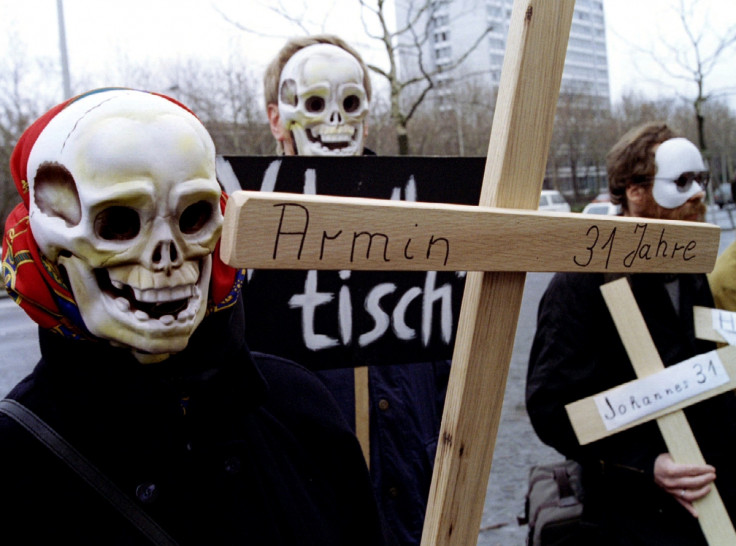World Haemophilia Day 2016: Contaminated blood scandal one of the biggest NHS treatment disasters

The fountains in Trafalgar Square in London's West End are set to glow red on Sunday 17 April to raise awareness for World Haemophilia day, a rare blood condition. This is also a clarion call to remember the so-called 'tainted blood scandal' in the 1970s and 1980s when around 5,000 people contracted HIV and Hepatitis C during treatment for haemophilia or blood transfusion by the NHS.
In acknowledgement of this, the Haemophilia Society recently launched a social media campaign to highlight that those affected by the #ContaminatedBlood scandal. The victims of the contaminated blood scandal demonstrated outside Parliament on 12 April as MPs debated the issue. Politicians are asking the government to recognise the contaminated blood scandal as one of the biggest treatment disasters in the history of the NHS.
The debate will call for the government to recognise some victims in England will be left worse-off under the proposed reforms and that key groups who have been affected by the scandal, such as widows and children of the dead, have been left out of the payout plans altogether.
Contaminated Blood Protest #BloodProtest #Haemophilia @BBCFergusWalsh @HaemoSocUK pic.twitter.com/FSF56O8U2j
— CampaignTB (@CampaignTB) April 12, 2016
Sue Threakall, of the campaign group Tainted Blood, told the Newham Recorder: "The reaction to the consultation has been one of dumb despair even among seasoned campaigners.
"There's absolute shock that a government that has been working with us and seemed to think they could get it right has got it so catastrophically wrong.
"It needs to go back to the drawing board. The government needs to say we got it wrong and we're going to revisit this - not in six months or 12 months but now."
Among the campaigners who joined the protest on 12 April were two women whose husbands both died as a result of the contaminated blood scandal. Ron Hill died in 2004 after being given blood infected with Hepatitis C during his NHS treatment for a clotting disorder, according to ITV. Sue Threakell was joined by her local MP for Barnstaple at the demonstration. Her husband died to due contracting HIV after he was given contaminated blood.
Campaigners are fighting for a financial settlement from the Government, with MPs criticising delays in implementing a £100 million compensation scheme which campaigners argue will leave some people worse off.
Despite warnings, the UK purchased haemophilia treatment from foreign high-risk paid donors. As part of the contaminated blood scandal, haemophilia patients received blood products carrying almost 6 times more risk of HIV infection and close to 100% chance of infection with Hepatitis C. Around 2,400 died as a result of the contaminated blood.
As part of the newly proposed reforms by the Government, support to the majority of the community would decrease by up to 30%. People in England stand to be worse off than they currently are and receive less support than in Scotland where when a haemophilia patient infected with contaminated blood dies, their spouse or civil partner will continue to receive 75% of their annual payment.
What caused the tainted blood?
The infections were allegedly due to plasma products such as Factor VIII that were sourced from the United States from large groups of donors who were sometimes paid for their donation. A documentary by investigative journalist Kelly Duda, Factor 8: The Arkansas Prison Blood Scandal alleges that for more than 20 years, the Arkansas prison system benefitted from selling blood plasma from prisoners infected with viral hepatitis and AIDS.
In the UK, no government, health or organisation has admitted liability for the scandal and no compensation has been paid to those affected. An independent inquiry into Contaminated Blood and Blood Products, chaired by Baron Archer of Sandwell, was set up to uncover the causes of the events that led to thousands of infections and deaths. Lord Robert Winston described it as "the worst treatment disaster in the history of the National Health Service".
What is haemophilia?
The condition is a hereditary genetic disorder that impairs the body from controlling blood clotting. Haemophilia A is a bleeding disorder where a protein made by the body to help make blood clot is either partly or completely missing, according to the Haemophilia Society. This protein is called a clotting factor: with haemophilia A there is a deficiency of clotting factor VIII (eight).
In around two thirds of cases there is a family medical history of haemophilia and mainly affects boys and men. Women can be 'carriers' of the affected gene and may experience symptoms. Although it is the most common type of haemophilia it is a rare condition, affecting about one in every 10,000 males.
Haemophilia A is classed as mild, moderate or severe, depending on the level of clotting factor VIII in the blood. The main symptoms are a tendency to bruise easily especially in childhood; a tendency to bleed into joints and muscles causing pain, swelling and impairment of movement. Bleeding episodes must be treated promptly to avoid lasting effects.
It is treated by replacing the missing clotting factor VIII in the blood through an intravenous infusion of clotting factor concentrate. In the UK most people with haemophilia A are treated with manufactured clotting factor concentrate (recombinant) although it can be made from human blood plasma as well (plasma derived). With the proper treatment people with haemophilia A can lead long and functioning lives. However, there is currently no cure for haemophilia A.
With haemophilia B, there is a deficiency of clotting factor IX (nine) and around two thirds have a family history of the disorder whilst in the rest it is a new case. Haemophilia B mainly affects boys and men; women can be 'carriers' of the affected gene and may experience symptoms. Only about 20% of people with haemophilia have haemophilia B, so it is a rare condition, affecting about one in every 50,000 males.
© Copyright IBTimes 2024. All rights reserved.







